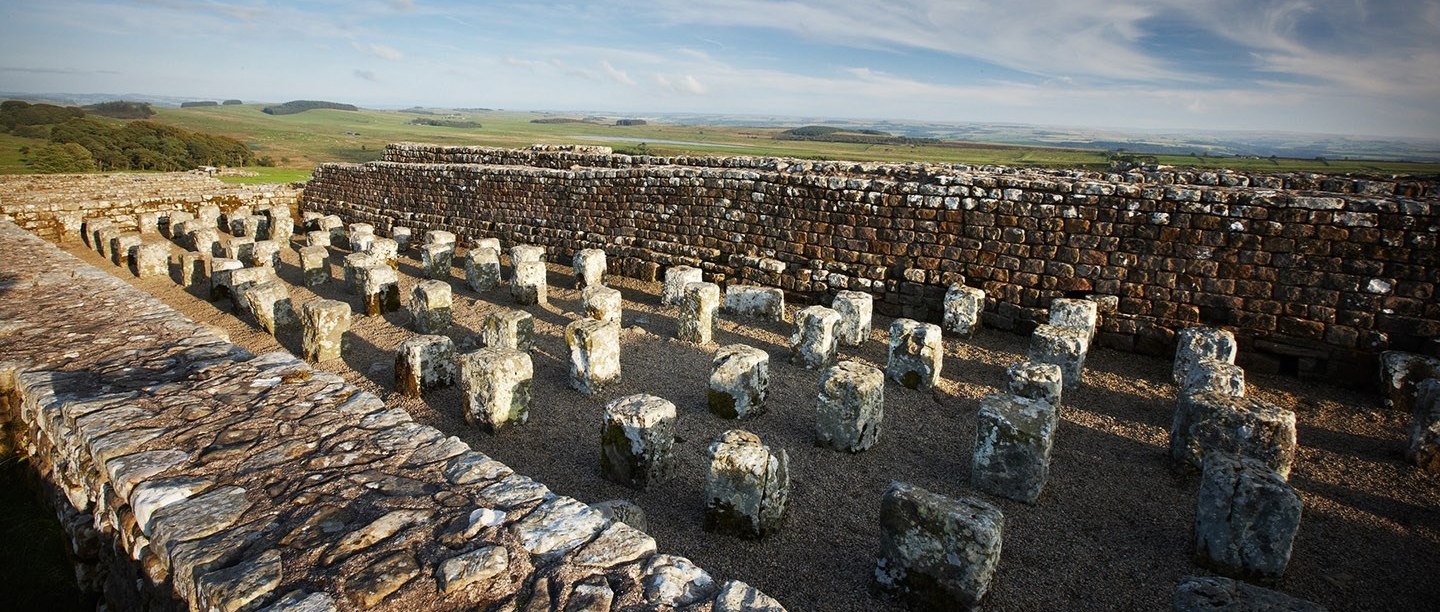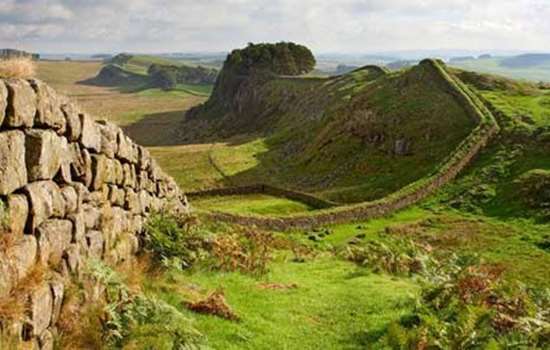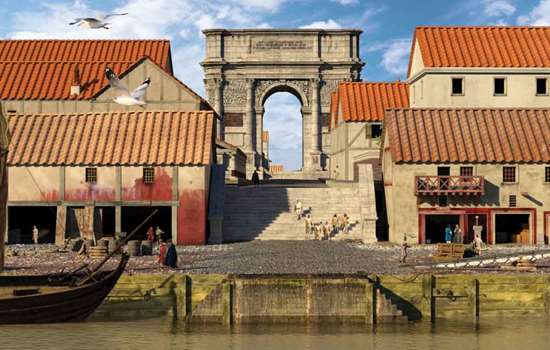The building of the fort
There is little evidence for pre-Roman activity at Housesteads. The first Roman presence is evident in the broad foundation of Hadrian’s Wall along the north edge of the escarpment, and in a turret (no. 36b), one of a regular system of towers and small forts (known as milecastles) along the line of the Wall. The turret now lies within the fort walls.
The building of the fort began before either the Wall at Housesteads or milecastle 37 to the west was completed.[1] The presence of a cremation burial in the north-west corner of the fort suggests that the timespan between the two building phases may have been more than a year:[2] Roman burials were always outside forts and settlements, so this cremation must pre-date the construction of the fort. Work on the Wall at Housesteads, at a narrower gauge, was resumed once the fort walls were complete.
Download a plan of Housesteads Roman fortThe Tungrian Garrison
Housesteads was a large fort covering 2.2 hectares, garrisoned by auxiliaries – infantry and cavalry raised from the conquered peoples of the empire. It was intended from the outset to hold an infantry regiment of 800 men, known as a milliary cohort. The cohors I Tungrorum (‘first cohort of Tungrians’) is known to have garrisoned the site from the late 2nd to the 4th centuries AD.
This unit of auxiliaries was originally recruited from German-speaking tribes in the district of Tongres, in modern Belgium. The unit had earlier been stationed at the nearby fort of Vindolanda, south-west of Housesteads: a tombstone from there records the death in battle of a legionary centurion commanding the regiment, probably early in Hadrian’s reign (AD 117–38).[3] The date of the unit’s move to the Wall at Housesteads is not known for certain.
Further evidence for the early presence of the Tungrians derives from two inscriptions. One is a small building stone with the initials of the cohort, used in the lower wall of the granaries – one of the original buildings of the Hadrianic fort, which underwent major rebuilding in AD 205–8.[4]
The second is a dedication by the first cohort of Tungrians to ‘the gods and goddesses’ in accordance with the oracle of Apollo in Claros, now in western Turkey.[5] Ten similar texts known from across the empire have all been associated with the outbreak of plague about AD 165.[6]
After Hadrian
By the end of Hadrian’s reign (AD 138), the great Wall was complete, and Housesteads was one of 15 forts and part of a total garrison of nearly 10,000 men along its length. The surviving plan of the main buildings and barracks dates largely to this time.
Within four years of Hadrian’s death, however, his successor, Antoninus Pius (r.138–61), began the construction of a second wall (the Antonine Wall), across the Forth–Clyde isthmus in central Scotland. It is often thought that Hadrian’s Wall was then abandoned, but recent excavations from Housesteads found no evidence for this.[7]
Although most of the Tungrians are indeed known to have occupied Castlecary Fort on the Antonine Wall, it seems that part of the garrison may have remained here. An altar to Jupiter and the god Cocidius from Housesteads, dedicated by soldiers of the Second Augustan Legion said to be on ‘garrison duty’, may date to this period.[8]
FIND OUT MORE ABOUT RELIGIOUS WORSHIP ON HADRIAN’S WALLHousesteads in the 3rd Century
The Antonine Wall was abandoned after AD 160 and Hadrian’s Wall was fully garrisoned for the next two centuries. Major construction work at Housesteads is known to have taken place from the later 2nd and 3rd centuries at the commanding officer’s house, the granaries and other buildings around the fort, although the barracks were largely unaltered.[9]
The gates and curtain wall also underwent a number of changes and repairs.[10] Outside the fort the undefended civilian settlement seems to have been at its fullest extent throughout this period.
From the early 3rd century there were in garrison additional units, which had been recruited beyond the Rhine frontier in Frisia, now north-east Holland. These are known from inscriptions as the cuneus Frisiorum (‘wedge of Frisians’) and the numerus Hnaudifridi (a mercenary unit named after its leader).[11] A distinctive form of pottery known from this period at Housesteads shows close parallels with examples from Frisia and reflects the soldiers’ maintenance of their native traditions and contacts.
Buy the Guidebook to Housesteads Roman FortThe End of Roman Rule
Towards the end of the 3rd century the barrack accommodation within the fort was radically transformed, and the settlement outside largely abandoned.[12] The fort’s defences also underwent major refurbishment at the same time. The effective size of the garrison is likely to have been reduced, and many of those previously living outside the fort may have retreated within the defences for security.
The last-known inscription, dating to about AD 300, is a fragmentary text to ‘the emperors’.[13] It may belong to a new monumental storehouse building (building 15) constructed beside the main east gate. The last reference to the garrison is probably in the Notitia Dignitatum, a late Roman list of military commands and civil service posts throughout the empire.[14] However, the date of compilation for that part of the Notitia covering the western empire is uncertain, so we cannot be sure how long the garrison remained in the final decades of the 4th or early 5th century.[15]
READ MORE ABOUT ROMAN BRITAINLater History
Roman rule in north Britain ended at the turn of the 5th century AD. Immediate post-Roman activity at Housesteads is indicated by a ‘cist’ burial in a water tank close to the north curtain wall. This may be associated with an apsidal structure nearby which is similar in size and form to a building at Vindolanda that has been identified as a church.[16]
There are no documentary references to Housesteads during the Middle Ages. The earliest use of the name appears in the 16th century when part of ‘House steads’ was reported as belonging to Nicholas Crane of Bradley Hall.[17]
By the end of that century the place was notorious as a lair of rustlers and thieves, chiefly the Armstrong family. The antiquary and traveller William Camden avoided the site for fear of the ‘ranke robbers thereabouts’.[18] From the 18th century the fort became a focus for antiquarian visitors to the Wall, a pre-eminence it has retained through the 19th century – when it formed the highlight of John Clayton’s ‘Roman Wall Estate’ – until the present.
FIND OUT MORE ABOUT THE ARMSTRONG FAMILYRead more about Housesteads Roman Fort
DOWNLOAD A PLAN OF HOUSESTEADS ROMAN FORT
About the Author
James Crow is Professor of Classical Archaeology at the University of Edinburgh. He is the author of the English Heritage Red Guide to Housesteads Roman Fort.



